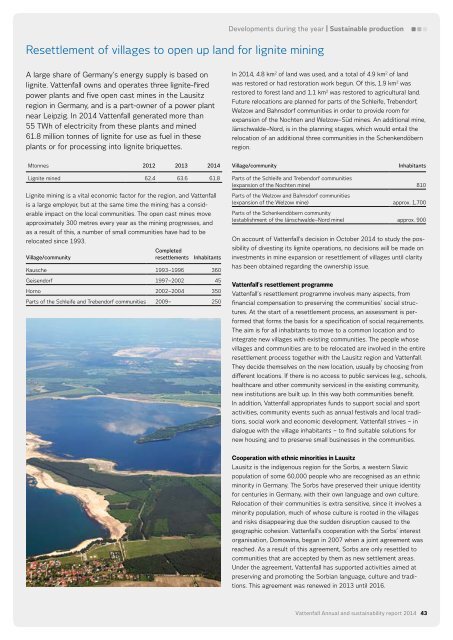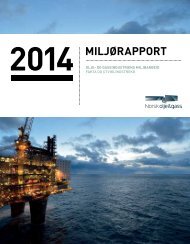Customer solutionsthat enable sustainableuse of energyEnsure<strong>sustainability</strong> inthe supply chainSafeguardthe company’sTransform theproduction portfoliotowards lowerCO 2 emissions<strong>and</strong> morerenewablesIncreasefocus on otheremissionsProtect nature<strong>and</strong> species<strong>and</strong> safeguardbiodiversityImprove resourceefficiencyin Vattenfall’soperationsintegrityTakeresponsibilityEnsure afor Vattenfall‘shealthy <strong>and</strong>impacts on localsafe workplaceOur employees communitiesSustainable consumptionSustainable productionDevelopments during the year | Sustainable productionTake responsibility for Vattenfall’s impacts on local communitiesSustainable financial performanceVattenfall’s operations have impacts on local communities– both positive <strong>and</strong> negative. Vattenfall’s lignite mineshave a large impact on local communities, including theoccasional necessity for people to resettle as a result ofmining operations. At the same time, mining operationscreate local jobs.To build <strong>and</strong> maintain local acceptance, mutual trust <strong>and</strong> a good reputation,Vattenfall strives to include stakeholders in decision-makingprocesses. Stakeholder engagement is crucial for Vattenfall’s licenceto operate as well as for the success of new projects <strong>and</strong> existingoperations.How is Vattenfall working with this?It is important for Vattenfall that the people who live close to thecompany’s operations are adversely affected as little as possible.Regardless of the type of impact the operations may have, Vattenfallstrives to be as responsive as possible to the affected stakeholders’needs <strong>and</strong> dem<strong>and</strong>s, regardless of their gender, age or ethnicity. Workon reducing impacts on local communities is continuously carriedout towards the goal of improving <strong>and</strong> adapting to local needs in theorganisation <strong>and</strong> to promote active collaboration with local interests.The Vattenfall Project Management Model (VPMM) is an obligatorytool used across the Group for governance <strong>and</strong> support for addressing<strong>and</strong> taking local interests into account in various projects. It is theresponsibility of each project manager to implement the project managementtool. All project managers, decision-makers <strong>and</strong> – to someextent – project participants are offered training in the tool.Activities during the yearIn cooperation with local authorities, Vattenfall has established a fund,the Pen y Cymoedd Community Fund in connection with thePen y Cymoedd Wind Energy Project in the UK.At an early stage of an ongoing project, Vattenfall engaged in adialogue with Gällivare skogssameby (a Sami village), one of the keystakeholders, to establish local acceptance of Vattenfall’s power linesnearby the Boliden mine in Gällivare. Discussions were held with villagerepresentatives on suitable areas in which the power lines couldbe drawn. By taking into account the interests of the local reindeerindustry, Vattenfall has established a relationship that has strengthenedconfidence in the ongoing process. The project is expected tobe completed in 2017.StrategyVattenfall will strive for active collaboration with local interestsin various projects in an effort to build mutual trust throughopenness <strong>and</strong> involvement in local communities, while complyingwith local laws <strong>and</strong> regulations <strong>and</strong> taking local expectationsinto account.Targets/KPIAll assets projects will take into account <strong>and</strong> address impactson the local communityVattenfall Reputation Index (VRI) score of 65 by 2020Achievements <strong>2014</strong>Local acceptance for new distribution line in northern SwedenEstablishment of a community fund in connection with thePen y Cymoedd Wind Energy Project, see belowChallengesNo follow-up or implementation of Vattenfall’s projectmanagement tool are performed at the Group level. As aresult, the quality <strong>and</strong> degree of stakeholder involvementmay vary from project to projectA more proactive approach requires investment of a greatamount of timePen y Cymoedd Community FundPen y Cymoedd Wind Energy Project is a 76 turbine wind powerdevelopment project in UK which will generate enough electricityto meet the needs of 140,000 homes per year. As part its localinvolvement, Vattenfall provided funding for the Pen y CymoeddCommunity Fund in cooperation with local authorities. Onceoperational the wind farm will generate GBP 1.8 million per yearfor the community fund for more than 20 years. Via web-basedplatform local citizens can propose how funds should be spent;so far suggestions have been received from more than 3,000residents. In this way the community has a say in how to use thewind farm benefits.Planned activitiesThe VPMM is under continuous improvement, <strong>and</strong> its processes <strong>and</strong>project quality are reviewed <strong>annual</strong>ly through a quality assuranceprocess. The results are analysed, <strong>and</strong> areas for improvement inthe coming year are discussed within a VPMM network comprisingrepresentatives from the business. Going forward, the VPMM projectnetwork will continue to highlight the importance of promoting stakeholderinvolvement in an effort to build trust <strong>and</strong> local acceptance. Development of Vattenfall Reputation Index, VRI7060Target by 2020504030201002012 2013 <strong>2014</strong>SwedenGermanyNetherl<strong>and</strong>sVattenfall’s reputation is measured through the Vattenfall Reputation Index (VRI). In Sweden theVRI score remains at a very low level. The level stablised in <strong>2014</strong>, but at a level that is lower thanfor the company’s main competitors. Vattenfall’s reputation in Germany <strong>and</strong> the Netherl<strong>and</strong>s ishigher than in Sweden <strong>and</strong> improved further in <strong>2014</strong>. The general public’s perceptions surroundingcommunity responsibility, <strong>sustainability</strong>, <strong>and</strong> products <strong>and</strong> services have the greatest impacton Vattenfall’s reputation. Vattenfall’s work with continuous improvement in these areas explainsthe positive development in both Germany <strong>and</strong> the Netherl<strong>and</strong>s.42 Vattenfall Annual <strong>and</strong> <strong>sustainability</strong> <strong>report</strong> <strong>2014</strong>
Developments during the year | Sustainable productionResettlement of villages to open up l<strong>and</strong> for lignite miningA large share of Germany’s energy supply is based onlignite. Vattenfall owns <strong>and</strong> operates three lignite-firedpower plants <strong>and</strong> five open cast mines in the Lausitzregion in Germany, <strong>and</strong> is a part-owner of a power plantnear Leipzig. In <strong>2014</strong> Vattenfall generated more than55 TWh of electricity from these plants <strong>and</strong> mined61.8 million tonnes of lignite for use as fuel in theseplants or for processing into lignite briquettes.In <strong>2014</strong>, 4.8 km 2 of l<strong>and</strong> was used, <strong>and</strong> a total of 4.9 km 2 of l<strong>and</strong>was restored or had restoration work begun. Of this, 1.9 km 2 wasrestored to forest l<strong>and</strong> <strong>and</strong> 1.1 km 2 was restored to agricultural l<strong>and</strong>.Future relocations are planned for parts of the Schleife, Trebendorf,Welzow <strong>and</strong> Bahnsdorf communities in order to provide room forexpansion of the Nochten <strong>and</strong> Welzow–Süd mines. An additional mine,Jänschwalde-Nord, is in the planning stages, which would entail therelocation of an additional three communities in the Schenkendöbernregion.Mtonnes 2012 2013 <strong>2014</strong>Village/communityInhabitantsLignite mined 62.4 63.6 61.8Lignite mining is a vital economic factor for the region, <strong>and</strong> Vattenfallis a large employer, but at the same time the mining has a considerableimpact on the local communities. The open cast mines moveapproximately 300 metres every year as the mining progresses, <strong>and</strong>as a result of this, a number of small communities have had to berelocated since 1993.CompletedVillage/communityresettlements InhabitantsKausche 1993–1996 360Geisendorf 1997–2002 45Horno 2002–2004 350Parts of the Schleife <strong>and</strong> Trebendorf communities 2009– 250Parts of the Schleife <strong>and</strong> Trebendorf communities(expansion of the Nochten mine) 810Parts of the Welzow <strong>and</strong> Bahnsdorf communities(expansion of the Welzow mine) approx. 1,700Parts of the Schenkendöbern community(establishment of the Jänschwalde–Nord mine) approx. 900On account of Vattenfall’s decision in October <strong>2014</strong> to study the possibilityof divesting its lignite operations, no decisions will be made oninvestments in mine expansion or resettlement of villages until clarityhas been obtained regarding the ownership issue.Vattenfall’s resettlement programmeVattenfall’s resettlement programme involves many aspects, fromfinancial compensation to preserving the communities’ social structures.At the start of a resettlement process, an assessment is performedthat forms the basis for a specification of social requirements.The aim is for all inhabitants to move to a common location <strong>and</strong> tointegrate new villages with existing communities. The people whosevillages <strong>and</strong> communities are to be relocated are involved in the entireresettlement process together with the Lausitz region <strong>and</strong> Vattenfall.They decide themselves on the new location, usually by choosing fromdifferent locations. If there is no access to public services (e.g., schools,healthcare <strong>and</strong> other community services) in the existing community,new institutions are built up. In this way both communities benefit.In addition, Vattenfall appropriates funds to support social <strong>and</strong> sportactivities, community events such as <strong>annual</strong> festivals <strong>and</strong> local traditions,social work <strong>and</strong> economic development. Vattenfall strives – indialogue with the village inhabitants – to find suitable solutions fornew housing <strong>and</strong> to preserve small businesses in the communities.Cooperation with ethnic minorities in LausitzLausitz is the indigenous region for the Sorbs, a western Slavicpopulation of some 60,000 people who are recognised as an ethnicminority in Germany. The Sorbs have preserved their unique identityfor centuries in Germany, with their own language <strong>and</strong> own culture.Relocation of their communities is extra sensitive, since it involves aminority population, much of whose culture is rooted in the villages<strong>and</strong> risks disappearing due the sudden disruption caused to thegeographic cohesion. Vattenfall’s cooperation with the Sorbs’ interestorganisation, Domowina, began in 2007 when a joint agreement wasreached. As a result of this agreement, Sorbs are only resettled tocommunities that are accepted by them as new settlement areas.Under the agreement, Vattenfall has supported activities aimed atpreserving <strong>and</strong> promoting the Sorbian language, culture <strong>and</strong> traditions.This agreement was renewed in 2013 until 2016.Vattenfall Annual <strong>and</strong> <strong>sustainability</strong> <strong>report</strong> <strong>2014</strong> 43



